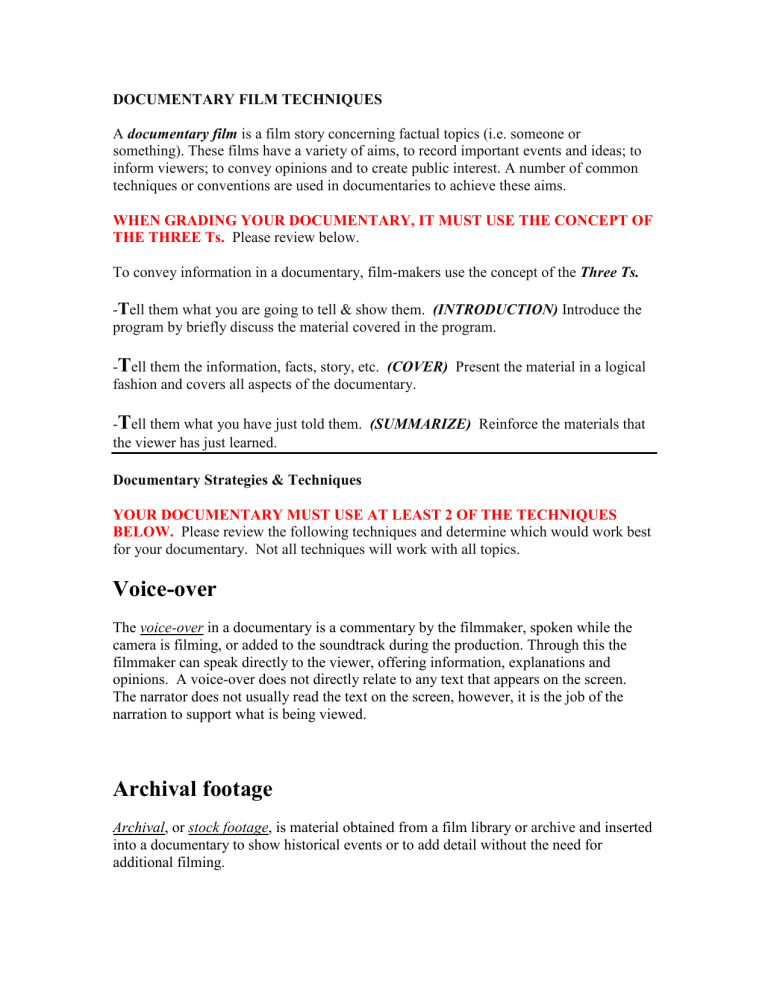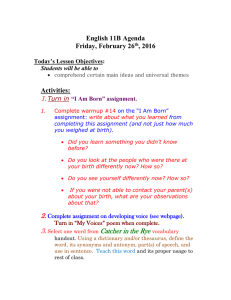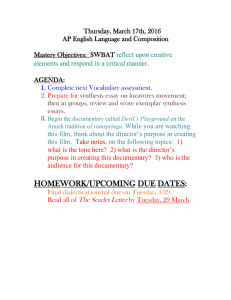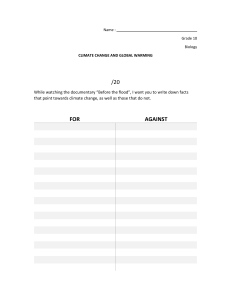
DOCUMENTARY FILM TECHNIQUES A documentary film is a film story concerning factual topics (i.e. someone or something). These films have a variety of aims, to record important events and ideas; to inform viewers; to convey opinions and to create public interest. A number of common techniques or conventions are used in documentaries to achieve these aims. WHEN GRADING YOUR DOCUMENTARY, IT MUST USE THE CONCEPT OF THE THREE Ts. Please review below. To convey information in a documentary, film-makers use the concept of the Three Ts. -Tell them what you are going to tell & show them. (INTRODUCTION) Introduce the program by briefly discuss the material covered in the program. -Tell them the information, facts, story, etc. (COVER) Present the material in a logical fashion and covers all aspects of the documentary. -Tell them what you have just told them. (SUMMARIZE) Reinforce the materials that the viewer has just learned. Documentary Strategies & Techniques YOUR DOCUMENTARY MUST USE AT LEAST 2 OF THE TECHNIQUES BELOW. Please review the following techniques and determine which would work best for your documentary. Not all techniques will work with all topics. Voice-over The voice-over in a documentary is a commentary by the filmmaker, spoken while the camera is filming, or added to the soundtrack during the production. Through this the filmmaker can speak directly to the viewer, offering information, explanations and opinions. A voice-over does not directly relate to any text that appears on the screen. The narrator does not usually read the text on the screen, however, it is the job of the narration to support what is being viewed. Archival footage Archival, or stock footage, is material obtained from a film library or archive and inserted into a documentary to show historical events or to add detail without the need for additional filming. Reenactment Reconstructions are also often used in documentaries. They are artificial scenes of an event which has been reconstructed and acted out on film based on information of the event. Reconstructions generally provide factual information, and give the viewer a sense of realism, as if the event really happened in front of them live. They often indicate that the footage is not real by using techniques such as blurring, distortion, lighting effects, changes in camera level, and color enhancement within the footage. Direct and Indirect Interviews The interview is a common documentary technique. It allows people being filmed to speak directly about events, prompted by the questions asked by the filmmaker. An interview may take place on screen, or off screen, on a different set. Interviews in a documentary give the viewer a sense of realism, that the documentary maker’s views are mutually shared by another person or source, and thus more valid. To achieve this much detail from what may be a one-hour interview, clips of only a few minutes are shown. Interviews on opposing sides of an issue may be shown to give the viewer comprehensive information about a topic. Montage A montage sequence conveys ideas visually by putting them in a specific order in the film. Narrative montages involve the planning of sequence of shots used to indicate changes in time and place within a film. Ideational montages link actions with words, and are often used in documentaries. A different positioning of shots conveys different ideas to the viewer. For example, a montage containing a negative theme followed by a positive theme may give the viewer the idea that the positive theme is the main theme of the montage. Montages in documentaries are usually linked with words that characters say. This visual representation of the characters thoughts helps position the viewer in the story, and helps the viewer better understand what the character is saying. It visually presents a progression of ideas on a screen. A photo montage is used in the same fashion and conveys the same ideas using still photographs inserted into the video. A voice-over supports a montage. Exposition In a documentary, the exposition occurs at the beginning and introduces the important themes of the film. It is important because it creates the viewer's first impression and introduces the viewer to the content. Dramatic segments of the documentary are specially chosen in order to catch the viewer’s attention. These shots are specifically positioned, such that the montage positions us to believe a certain theme presented by the documentary and this the documentary presents its view much more persuasively to the viewer. This acts as a pre-view to the rest of the documentary. Wallpaper Technique Documentaries often need to convey abstract information – usually by voice-over narration. Since abstract concepts have no physical existence, they are impossible to record visually. But because the screen cannot be blank, the film maker and script writer must invent visuals that appear plausibly connected to the narration, even if they do not show what is actually being talked about on the sound track narration. This type of related visual is called wallpaper. An example of the wallpaper technique could be: A documentary about a particular county that does not have natural resources or a manufacturing industry, but has a water transportation and shipping industry, can discuss how they rely, as a nation, on boats for income. This is a topic that cannot be filmed, but clips and/or stills of their boats in action and in port can be used to fill the time slot while the narration takes place. Actuality Actuality is the term for raw film footage of real life events (reality), places and people as opposed to fictional films which use actors, scripted stories and artificial sets. Documentaries are not pure actuality films - rather they combine actuality with explanation, commentary, and perhaps even dramatization.




